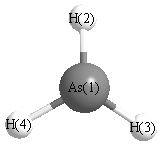Geometric Data

Point Group C3v
Internal coordinates
distances (r) in Å, angles (a) in degrees, dihedrals (d) in degrees
Cartesians
| Atom |
x (Å) |
y (Å) |
z (Å) |
| As1 |
0.0000 |
0.0000 |
0.0700 |
| H2 |
0.0000 |
1.2558 |
-0.7700 |
| H3 |
1.0875 |
-0.6279 |
-0.7700 |
| H4 |
-1.0875 |
-0.6279 |
-0.7700 |
Atom - Atom Distances 
Distances in Å
| |
As1 |
H2 |
H3 |
H4 |
| As1 |
|
1.5108 | 1.5108 | 1.5108 |
| H2 |
1.5108 |
|
2.1751 | 2.1751 |
| H3 |
1.5108 | 2.1751 |
|
2.1751 |
| H4 |
1.5108 | 2.1751 | 2.1751 |
|
Calculated geometries
for AsH
3+ (Arsine cation).
Experimental Bond Angles (degrees) from cartesians 
| atom1 |
atom2 |
atom3 |
angle |
|
atom1 |
atom2 |
atom3 |
angle |
| H2 |
As1 |
H3 |
92.083 |
|
H2 |
As1 |
H4 |
92.083 |
| H3 |
As1 |
H4 |
92.083 |
Bond descriptions
Examples: C-C single bond, C=C, double bond, C#C triple bond, C:C aromatic bond
Connectivity
| Atom 1 |
Atom 2 |
| As1 |
H2 |
| As1 |
H3 |
| As1 |
H4 |












